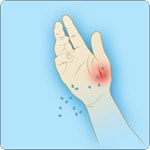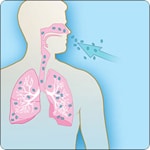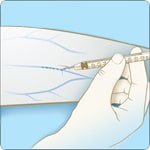Types of Anthrax
The type of illness a person develops depends on how anthrax enters the body. Typically, anthrax gets into the body through the skin, lungs, or gastrointestinal system. All types of anthrax can eventually spread throughout the body and cause death if they are not treated with antibiotics.
Cutaneous anthrax is the most common form of anthrax infection, and it is also considered to be the least dangerous. Infection usually develops from 1 to 7 days after exposure.
When anthrax spores get into the skin, usually through a cut or scrape, a person can develop cutaneous anthrax. This can happen when a person handles infected animals or contaminated animal products like wool, hides, or hair. Cutaneous anthrax is most common on the head, neck, forearms, and hands. It affects the skin and tissue around the site of infection.
Without treatment, up to 20% of people with cutaneous anthrax die. However, with proper treatment, almost all patients with cutaneous anthrax survive.
Inhalation anthrax is considered to be the most deadly form of anthrax. Infection usually develops within a week after exposure, but it can take up to 2 months.
When a person breathes in anthrax spores, they can develop inhalation anthrax. People who work in places such as wool mills, slaughterhouses, and tanneries may breathe in the spores when working with infected animals or contaminated animal products from infected animals. Inhalation anthrax starts primarily in the lymph nodes in the chest before spreading throughout the rest of the body, ultimately causing severe breathing problems and shock.
Without treatment, inhalation anthrax is almost always fatal. However, with aggressive treatment, about 55% of patients survive.
Gastrointestinal anthrax has rarely been reported in the United States. Infection usually develops from 1 to 7 days after exposure.
When a person eats raw or undercooked meat from an animal infected with anthrax, they can develop gastrointestinal anthrax. Once ingested, anthrax spores can affect the upper gastrointestinal tract (throat and esophagus), stomach, and intestines, causing a wide variety of symptoms.
Without treatment, more than half of patients with gastrointestinal anthrax die. However, with proper treatment, 60% of patients survive.
This type of infection has never been reported in the United States.
Recently, another type of anthrax infection has been identified in heroin-injecting drug users in northern Europe.
Symptoms may be similar to those of cutaneous anthrax, but there may be infection deep under the skin or in the muscle where the drug was injected. Injection anthrax can spread throughout the body faster and be harder to recognize and treat. Lots of other more common bacteria can cause skin and injection site infections, so a skin or injection site infection in a drug user does not necessarily mean the person has anthrax.



